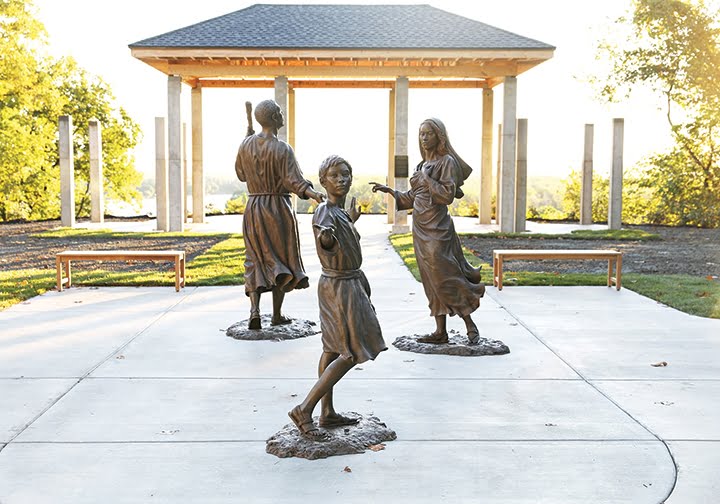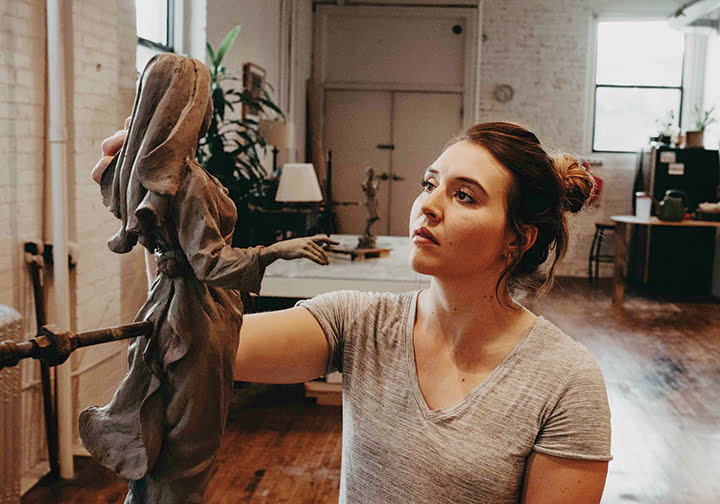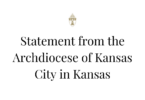
by Karen Bonar
Special to The Leaven
ATCHISON — The bronze sculpture “The Holy Family’s Return to Nazareth” was unveiled Sept. 27 at St. Benedict’s Abbey here. The sculpture, which is part of the new Return to Nazareth Prayer Garden, was created by St. Francis native Kate Marin.
“It is difficult to put into words how much it means to me that this is the place my first professional work will reside forever,” said Marin, who is a 2012 graduate of Benedictine College in Atchison. “A large part of my heart is there. I think it’s poetic the way the Lord brought all of this together. It was a sweet way to enter into the space of being a working artist.”
The project began with a gift from Mike and Mary Alice Easterday, who approached the abbey with the idea to create a prayerful garden.
“They approached us about creating a garden that would allow the person to engage in it — whether praying or walking among the statues — to have an experience of walking with the Holy Family,” said Abbot James Albers, OSB.
As the project developed, Abbot James said it was important to partner with students, so two students from the school’s new architecture program were asked to design the garden. The students approached Marin and asked her to submit a proposal.
“All three of them prayed over this Gospel (Luke 2), and the fruit of that is what we will unveil,” Abbot James said in an interview before the event. “I think it’s an extremely beautiful way to honor the Holy Family.”
Monks instrumental in sculptor’s faith journey
Upon her college graduation in 2012, Marin worked as an adjunct professor at Benedictine.
“I really kept a strong relationship with the abbey,” she said. “I went to many Masses and had a spiritual director who was a monk. Their Masses, their spirituality, their liturgy, were instrumental in my own faith journey.”

This is Marin’s first commission as a professional artist, and her second time working with bronze material. About a year ago, she returned to the Midwest from Italy, where she was completing her education at the Scuola di Arte Sacra (Sacred Art School) of Florence. The move stateside allowed her to be closer in proximity to the foundry in Colorado, which translated her clay sculptures into bronze.
The statues are slightly larger than life. The statue of St. Joseph is 7 feet tall; Mary is 6 feet, 4 inches; and the 12-year-old rendition of Jesus is 5 foot, 2 inches.
“I made my Jesus at a point where, even larger than life, he still stands a bit shorter than the visitors who will come to the site,” Marin said. “I thought it was tender for Jesus to gaze up at them.”
While the theme of returning to Nazareth is one Marin said could bring up images of the Holy Family returning after their exile in Egypt, she said the project coordinators took a slightly different approach. The inspiration came from the Gospel of Luke: “He went down with them and came to Nazareth, and was obedient to them; and his mother kept all these things in her heart” (2:51), referring to the Holy Family’s return to Nazareth after the finding of the child Jesus in the temple.
Abbot James said the subtext of the Gospel is one of obedience.
“The theme is of obedience, eventually to Christ’s obedience on the cross,” Abbot James said. “In the Gospel, the idea is Christ is obedient to Mary and Joseph, and also to the Father. From this obedience, love of mercy comes to us. It’s one of the vows we take as Benedictine monks.”
Over about two months, Marin sculpted the life-size version in Loveland, Colorado, to be in close proximity to her foundry, Art Castings of Colorado. Once sculpted, the foundry made wax casts out of the original mold taken from the clay figures. She had to make slight adjustments to the wax casts and, once satisfied, bronze was poured into the molds to create the statues. The statues are large and were created in multiple pieces. Once all pieces were complete, they were all welded together to create the final statues.
‘It was a language I could speak’
A native of northwest Kansas, Marin said she always appreciated art, but never envisioned life as a professional artist.
“I think a lot of artists have memories growing up drawing or creating,” she said. “I know I was a creative kid, but I don’t have memories of having to make art all the time.”
She availed herself of the art classes available in high school, and when she went to Benedictine, opted to explore it further.
“I have a love for learning. I was excited to go to college and learn about things I’d never learned about, which was art,” Marin said. “I always really liked art, looking at paintings, seeing sculptures. It was always fascinating to me. I was always curious about it. Once I was in art classes, it was the language of my soul.”
During college, she spent a semester in Florence. Upon her 2012 graduation with degrees in art and theology, she then returned to Florence and attended a monthlong immersion program.
“The first week was sculpture, and we were sculpting the portrait of a live model,” she said. “It was life-changing because I had never sculpted, but I was pleased with my sculpture. I had struggled with painting and drawing, but sculpture was something I felt so fluent in.
“I got a taste for it and felt this was what I was made for, which was powerful. It was a language I could speak and I wanted to speak. I could lose myself for hours.”
‘You just need eyes to see’
She returned to Kansas and worked for several years in order to return to study in Florence, which she did from 2017-19.
“By this point, I knew I wanted a classically trained education within the faith,” Marin said. “I knew I wanted to make work within the church.”
In October 2017, she won first place for her sculpture “Ecce Homo” in the inaugural Regional Juried Christian Arts Competition and Exhibition presented by the Catholic Fine Arts Council of the Archdiocese of Kansas City in Kansas.
“I spent so much time in Europe seeing those beautiful churches, seeing the integrity of design and art in those places,” Marin said. “It makes such a difference in people’s ability to pray, while surrounded by art and beauty. I love the idea of supporting that spirituality and infusing our culture with that spirituality.
“God speaks in the silence,” she added. “Art doesn’t take words; you just need eyes to see. You can speak loudly with art without any words.”
Being selected to create sculptures for her alma mater was moving.
“The monks mean so much to me and it is an honor and a joy to be able to install a work of sacrifice, prayer and love that will hopefully be a gift to them for hundreds of years to come,” she said.
The connection she felt to not only the project, but its final home, helped propel her through the process.
“On the hard days, when I was sculpting, I would think, ‘This is a gift to the monks you already love,’” Marin said.
Reprinted with permission from The Register of the Diocese of Salina.






